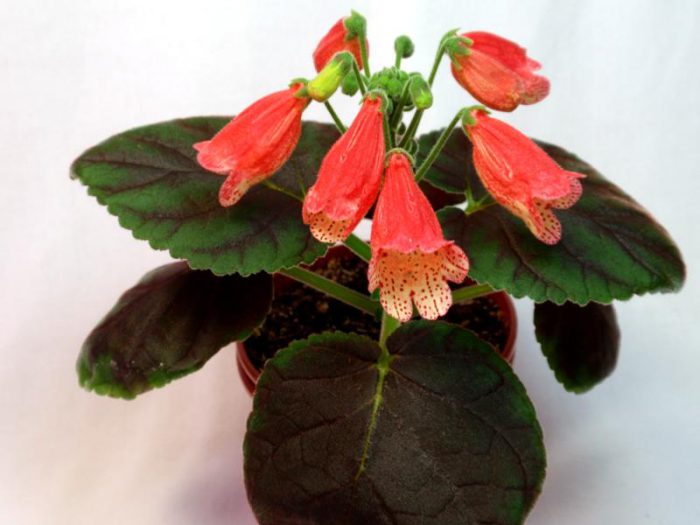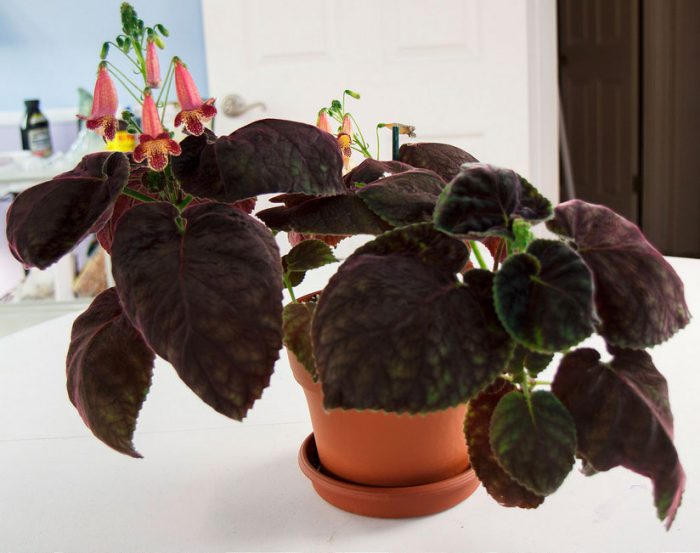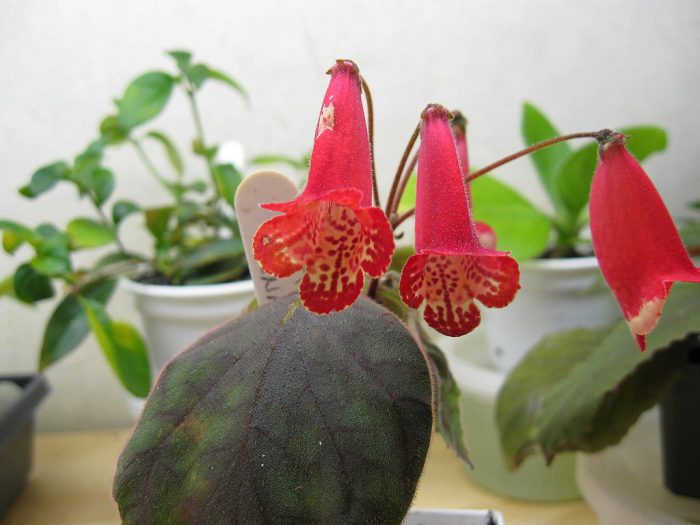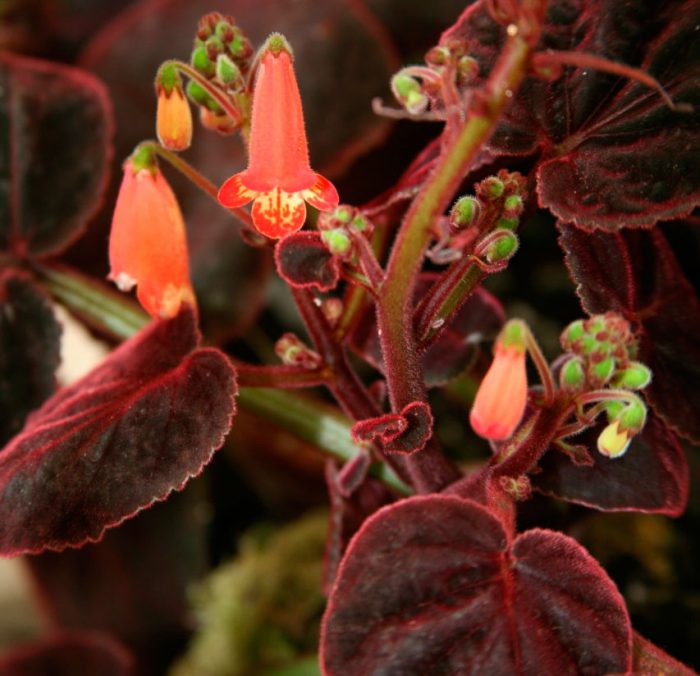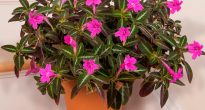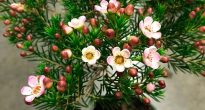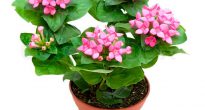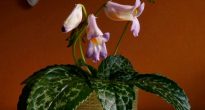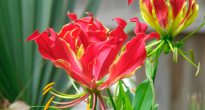Plant of the genus smithiante is directly related to the Gesneriaceae family. This genus unites approximately 8 plant species. There are sources in which this plant is called helium. In nature, it can be found in the mountains of Central and South America. This plant began to be cultivated in 1840. This genus got its name in honor of Matilda Smith. She worked as a painter at Kew, a private English botanical garden.
Such a plant is herbaceous. It has straight, pubescent stems that can reach 70 centimeters in height. The roots are scaly, like those of achimenes. Shoots are straight. The pubescent brownish-green leaves grow asymmetrically. They have the shape of an oval or heart.
Hanging flowers, collected in a brush, are similar to bells. They do not have peri-flowering leaves. Smithianthus flowers can be painted in different colors, for example: red, white, pink or reddish orange. There are yellow flowers, while in the throat they have specks of a contrasting color shade. Miniature forms are also grown at home. These flowers have a pronounced rest period. So, after flowering ends, the part of the flower that is above the ground dies off.
Content
Caring for a smithian at home
Illumination
Needs bright, but diffused lighting. For placement, it is recommended to select windows of western or eastern orientation. If the flower is placed on the sill of a south-facing window, then it needs shading from the direct midday rays of the sun (tulle works well). On north-facing windows, the smithian may not allow normal vegetation.
Temperature regime
From the beginning of the spring to the middle of the autumn, it is recommended to maintain the air temperature from 23 to 25 degrees. When the leaves die off, the temperature can be reduced to 20 degrees Celsius.
How to water
From March to October, the plant needs abundant watering, which is carried out after the top layer of the substrate dries out. However, make sure that water does not stagnate in the soil, and also do not allow the earthen coma to dry out completely. Watering too much can cause root rot. It is recommended to use bottom watering with settled water. This is because water trapped in foliage can ruin the plant's showy appearance.When the stems die off (during the dormant period), it is necessary to provide very poor watering to the plant, only occasionally moistening the substrate.
Air humidity
This plant needs high humidity, otherwise its leaves begin to curl. It is impossible to moisten the smithiante from the sprayer, as this negatively affects its appearance. Experienced flower growers recommend pouring expanded clay into the pan and pour in a little water.
Fertilizer
During active growth, the flower needs feeding. For this fertilizer must be dissolved in water in such a concentration that it is necessarily below normal.
Reproduction methods
The plant can be propagated by seeds, division or cuttings.
It is recommended to sow seeds from mid-winter to mid-spring. Level the substrate in the container and moisturize it. Spread the seeds over the surface, and do not sprinkle them with soil, as they need bright lighting for germination. To maintain high humidity, the container must be covered with glass or film. After 3 weeks, the seedlings will appear, which after 1 month must be transplanted into the dive boxes. After 1–1.5 months, the seedlings should be transplanted into separate pots. Only 6 months after transplanting into a large container, the smithian will begin to bloom. When the flowering ends, the stems above the ground will die off from the plant. The pot is placed in a place with a temperature of 15 degrees, while watering must be almost completely stopped.
Smitanta can be propagated by cuttings during the entire period of active growth. For the cutting, the apical shoot must be cut, the length of which must be at least 5 or 6 centimeters. For rooting, you can use a glass of water, as well as soil for the Saintpaulias, in which the cutting should be planted. Humidity should be fairly high between 70 and 80 percent.
When transplanting a flower in the last days of February, you can divide its root. Parts of the cut root should be placed in the ground to a depth of 2 centimeters, placing them horizontally. In a pot with a ten-centimeter diameter, three parts of the root should be planted at once.
Diseases and pests
The plant can be occupied by such harmful insects as whitefly, thrips or pincers.
During intensive growth, a plant such as smithiante becomes very similar to its closest relative, koleriya. The difference between these plants is that the dormant period is clearly expressed in the Smithyanta, since its aerial part completely dies off. In winter, the stalks of the coleria are exposed, and the aerial part dies off completely quite rarely.
Most often, the smithian begins to get sick due to the fact that she is not properly looked after:
- Brownish spots appear on the foliage surface... There are several reasons for this. So, the appearance of such spots can provoke watering with hard or very cold water. Mechanical damage or liquid on the foliage can also contribute to this.
- Greyish bloom on foliage - this may indicate that the room has too high humidity and there is practically no ventilation. Most often, this is a fungal disease.
- Foliage burns - in the case when the flower is under direct sunlight for a long time or it is overheated, pale yellow spots may appear on the surface of the leaves. Move the plant to shade and provide fresh air. In the event that the soil in the pot is completely dry, watering should be done, but only after it has completely cooled down. Smitiante south-facing windows should provide good ventilation and diffused lighting. Also, the leaves may turn yellow due to a lack or excess of minerals in the soil.
- Lack of flowering - if the rules of leaving are violated. This is observed with poor lighting or lack of nutrients in the soil. The plant may not bloom due to incorrect temperature conditions or incorrect maintenance during the dormant period.
Video review
Main types
Smithiantha x hybrida
Erect shoots. The dark green, velvety leaves are heart-shaped. Paniculate inflorescences consist of numerous flowers on pedicels. The shape of the flowers is similar to a narrow bell. They can be colored pink, deep orange or yellow. This species has a long flowering period, so it lasts from August to March. When flowering ends, there is a dormant period. The Prelude variety is distinguished by its yellow throat and dark red corolla tube. The white lobes of the limb have reddish streaks and specks.
Smithiantha zebrina
This perennial species has been grown since the 40s of the 19th century. It has erect stems, reaching a height of 60 centimeters. Located opposite broadly oval leaves, reaching 15 centimeters in length. The leaves are velvety, rich green, with jagged edges and brownish-purple veins. The flowers, up to 4 centimeters long, are collected in loose brushes located at the top of the bush. There are reddish specks in the throat of the corolla of rich orange color. Flowering is observed, as a rule, in the summer.
Smithiantha cinnabarina
This herbaceous plant can reach a height of 30 centimeters. Long (up to 15 centimeters), wide leaves with serrated edges are covered with reddish hairs. Bell-shaped flowers reach a length of 4 centimeters, and their corolla is tubular. Red flowers have a yellow center. They are collected in a brush similar to a pyramid, reaching a height of 25 centimeters. At the end of the autumn period, the plant can have up to 100 flowers. Flowers grow both at the top and in the leaf axils.
Smithiantha multiflora
This very showy plant is covered with soft hair. It is found naturally in Mexico and can reach a height of 30 centimeters. The leaves are heart-shaped and they are colored green. The creamy white flowers reach 4 centimeters in length. This species is often used to create hybrids. Typically, the plant blooms in the summer.

